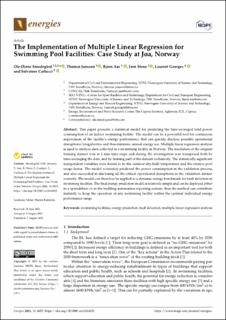| dc.contributor.author | Smedegård, Ole Øiene | |
| dc.contributor.author | Jonsson, Thomas | |
| dc.contributor.author | Aas, Bjørn | |
| dc.contributor.author | Stene, Jørn | |
| dc.contributor.author | Georges, Laurent | |
| dc.contributor.author | Carlucci, Salvatore | |
| dc.date.accessioned | 2022-10-26T09:47:59Z | |
| dc.date.available | 2022-10-26T09:47:59Z | |
| dc.date.created | 2021-08-24T15:24:54Z | |
| dc.date.issued | 2021 | |
| dc.identifier.citation | Energies. 2021, 14 (16), . | en_US |
| dc.identifier.issn | 1996-1073 | |
| dc.identifier.uri | https://hdl.handle.net/11250/3028372 | |
| dc.description.abstract | This paper presents a statistical model for predicting the time-averaged total power consumption of an indoor swimming facility. The model can be a powerful tool for continuous supervision of the facility’s energy performance that can quickly disclose possible operational disruptions/irregularities and thus minimize annual energy use. Multiple linear regression analysis is used to analyze data collected in a swimming facility in Norway. The resolution of the original training dataset was in 1 min time steps and during the investigation was transposed both by time-averaging the data, and by treating part of the dataset exclusively. The statistically significant independent variables were found to be the outdoor dry-bulb temperature and the relative pool usage factor. The model accurately predicted the power consumption in the validation process, and also succeeded in disclosing all the critical operational disruptions in the validation dataset correctly. The model can therefore be applied as a dynamic energy benchmark for fault detection in swimming facilities. The final energy prediction model is relatively simple and can be deployed either in a spreadsheet or in the building automation reporting system, thus the method can contribute instantly to keep the operation of any swimming facility within the optimal individual energy performance range. | en_US |
| dc.language.iso | eng | en_US |
| dc.publisher | MDPI | en_US |
| dc.rights | Navngivelse 4.0 Internasjonal | * |
| dc.rights.uri | http://creativecommons.org/licenses/by/4.0/deed.no | * |
| dc.title | The implementation of multiple linear regression for swimming pool facilities: Case study at Jøa, Norway | en_US |
| dc.title.alternative | The implementation of multiple linear regression for swimming pool facilities: Case study at Jøa, Norway | en_US |
| dc.type | Peer reviewed | en_US |
| dc.type | Journal article | en_US |
| dc.description.version | publishedVersion | en_US |
| dc.source.pagenumber | 23 | en_US |
| dc.source.volume | 14 | en_US |
| dc.source.journal | Energies | en_US |
| dc.source.issue | 16 | en_US |
| dc.identifier.doi | 10.3390/en14164825 | |
| dc.identifier.cristin | 1928399 | |
| cristin.ispublished | true | |
| cristin.fulltext | original | |
| cristin.qualitycode | 1 | |

